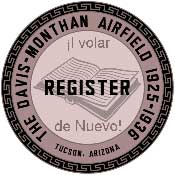|
Donald W. Douglas was a VIP Register signer, even at the time he visited with us at Tucson in the late 1920s. Indeed, he gave his name to some of the most significant and successful civil,military and commercial aircraft ever constructed and flown in the 20th century. The majority of landings by aircraft signed into the Davis-Monthan Register are Douglas models (718 of them). His name in the aircraft industry endures in the 21st century.
Donald W. Douglas (Source: NASM)
 |
But, he is not alone among the illustrious people who signed our Register whose companies also made great airplanes. Consider also Bill Piper, and Eddie Stinson; Bill Lear and Walter Beech, Morton Bach, Donald Luscomb and T. Claude Ryan.
Donald Douglas landed four times as a passenger with three different pilots. He landed three times in Douglas military aircraft, and once in a civilian-registered deHavilland. Neither his pilots nor he cited in the Register any reasons for their flights, however they were probably in association with military contracts for Douglas aircraft.
His first landing was on Tuesday, October 19, 1926. His pilot was Carl A. Cover. Based at Santa Monica, CA, where the Douglas Factory was located, they were westbound from Marfa, TX to Santa Monica. They were flying in the Douglas O-2C, 26-400.
His next two landings were with Victor E. Bertrandias. On Thursday, March 17, 1927, they were flying in the Douglas C-1C Transport, 26-423. Bertrandias stated his home base as McCook Field, Dayton, OH. They were eastbound from Santa Monica, CA. They remained in Tucson overnight and continued the next morning at 8:40AM to "El Paso, TX enroute to Dayton, OH." On August 25, 1927, Douglas and Bertrandias repeated that route in the Douglas O-2H, 27-288.
Finally, on November 7, 1928, Douglas landed with pilot Eric Springer in deHavilland DH-1, NX7281. Based at Santa Monica, they gave their itinerary as Yuma, AZ to El Paso, TX. Please direct your browser to the link for the airplane to learn of its brief life. At the time, Springer was test pilot for Martin Aircraft Co.
Douglas was born April 6, 1892 in Brooklyn, NY. He attended preparatory school in New York City and entered the U.S. Naval Academy at Annapolis in 1909. Despite high academic standing, he resigned after three years to study aeronautical engineering at Massachussetts Institute of Technology (MIT; fellow Register signers Emile Choureé, Jimmie Doolittle and E.E. Aldrin were also MIT graduates). Armed with a Bachelor of Science degree in 1914, he served a year at MIT as an instructor in aeronautical engineering. Visit Aldrin's link to see the kinds of examinations MIT aeronautical engineering students were asked to take. Try out your math skills.
Douglas Departure From Martin, Co. (Source: Flying)
 |
He became consultant to the Connecticut Aircraft Co. in 1915 and chief engineer for the Glenn L. Martin Co. a year later. His departure from Martin was captured in a brief article in the journal Flying in the June, 1920 issue, left. In 1920, he moved his family to California to start his own aircraft manufacturing venture. He was not yet 30 years old, with capital of $600.
Douglas' first airplane was made to satisfy a contract with a private Los Angeles sportsman to build a craft to fly across the U.S. nonstop. In partnership with David R. Davis, the "Cloudster" emerged to satisfy the contract. Although engine problems terminated the transcontinental attempt, the "Cloudster" was a significant advancement in aircraft design, in that it was the first airplane to get off the ground with a useful load equal to its own weight. Later, the same basic design was used to build the U.S. Navy's first torpedo-bomber. Below, courtesy of the San Diego Aerospace Museum (SDAM), a portrait of Douglas (left) and Davis. Note the unfiltered cigarettes.
Donald W. Douglas (L) & David R. Davis, Ca. Early 1920s (Source: SDAM)
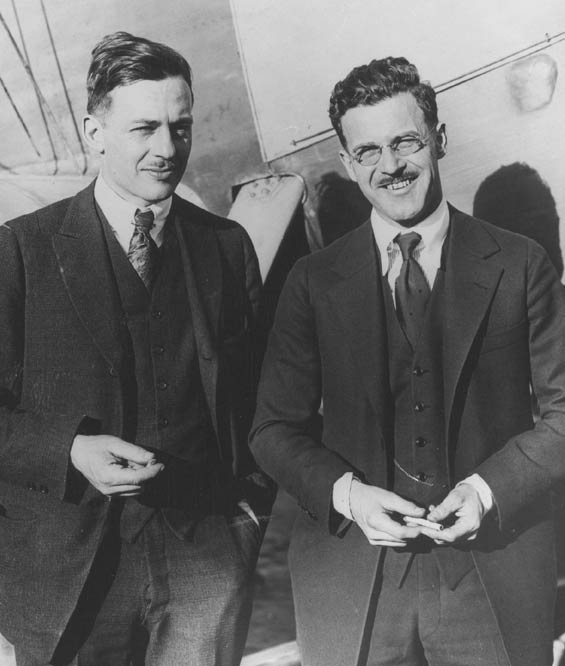 |
Below, from the SDAM, a view of the unfinished "Cloudster" with Douglas seated at right on the wing root in high-top shoes next to Davis. On August 27, 2016 I heard from the grandson of He stated, "In answer to the question about who is in the 1923 photo with Donald Douglas, the man on the far left is William Mellors "Bill" Henry, Sports Editor of the Los Angeles Times.... When Douglas awarded my Grandfather Bill with a model of the Cloudster, it was inscribed with "in the beginning, there was Bill Henry." The Cloudster is among several models of Douglas aircraft in the Bill Henry Room at Occiidental College Library. Henry (class of 1914) is also honored by naming the Oxy track (constructed for the 1984 Los Angeles Olympics) since he was the sports technical director of the 1932 L.A. Olympics and public address announcer at the L.A. Memorial Coliseum and author of the 'Approved History of the Olympic Games.'"
The other gentlemen are unidentified. Does anyone KNOW who they are?
Donald W. Douglas with the "Cloudster," Ca. 1923 (Source: SDAM)
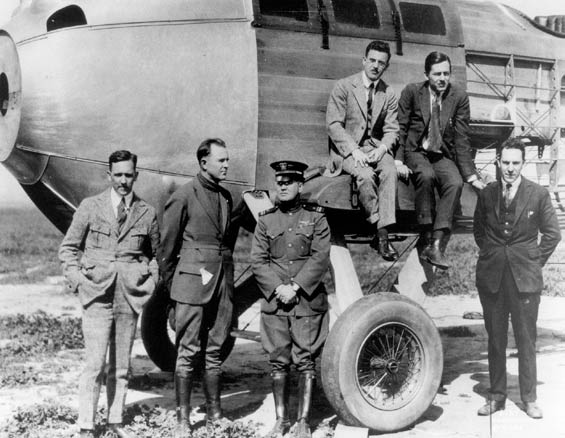 |
Although abandoned by the military, Register pilot and manufacturer T. Claude Ryan bought the "Cloudster" in 1925 and converted it for use on his Los Angeles-San Diego passenger airline. Below, from the SDAM, the "Cloudster" in Ryan livery on his air transit route. Note the relatively crude wheel pants and the exhaust stacks extending from the engine over the top wing.
The Douglas "Cloudster," Location Unknown, Ca. 1925+ (Source: SDAM)
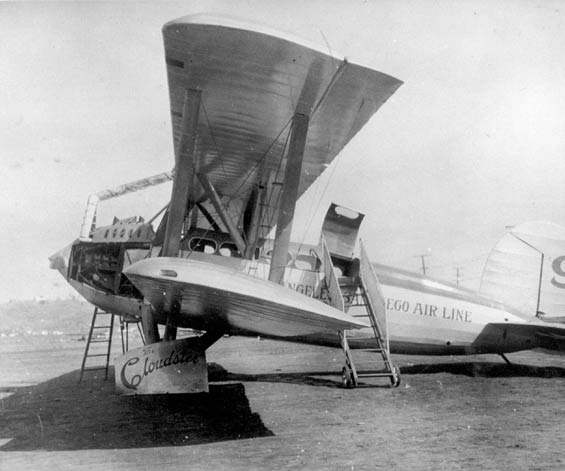 |
Douglas's next major contract was again with the Army. The Army's World Flight of 1924 is widely documented on the Web and in print. The Douglas World Cruisers were designed and constructed for the first ever round-the-world flight. These airplanes left Clover Field, Santa Monica, CA in March, returning to Seattle, WA in October, covering 27,553 miles in six months and six days, with an actual flying time of 371 hours. Douglas's aircraft had touched down in 28 countries and had crossed the Atlantic and Pacific Oceans.
The World Flight was acclaimed as the greatest in aviation up to that time, and created the Douglas Aircraft trade slogan, "First Around the World." The aircraft are pictured during their stop at Tucson, September 28, 1924, at the Cosgrove Collection on this site. Among the pilots and crew of the World Cruisers, Henry Ogden, Leigh Wade, Alva Harvey, Lowell Smith, Leslie Arnold and Erik Nelson signed our Register at later dates, flying different aircraft. For most of them, the First World Flight was their 15-minutes of fame that remained with them the rest of their lives. Please direct your browser to their links for insight into their personalities and the World Flight.
Douglas aircraft filled military training roles during the 1930s, and played a major role for U.S. air power during WWII and the Korean conflict. In 1933, Douglas began building the first practical passenger transports, the prototype DC-1, and and the DC-2. The motivation for building the earliest of these transports is an interesting connection with another Register pilot, Jack Frye. Frye was vice president of Transcontinental and Western Air (TWA), having a few years earlier formed and operated Standard Air Lines (PDF, 670kB), which was merged into TWA. In 1932, Frye sent a letter to various manufacturers challenging them to design and produce a THREE-engine airliner capable of carrying at least 12 passengers and flying at least 145 MPH. Douglas proposed a two-engine airplane that would carry 14 passengers and travel at 180 MPH. His proposal won, and the DC-1 was produced. A single DC-2, NC14282, is a Register airplane. Below, from SDAM, an unidentified DC-2 seeing duty with the Flying Tigers in China.
Douglas DC-2, China, Ca. 1940s (Source: SDAM)
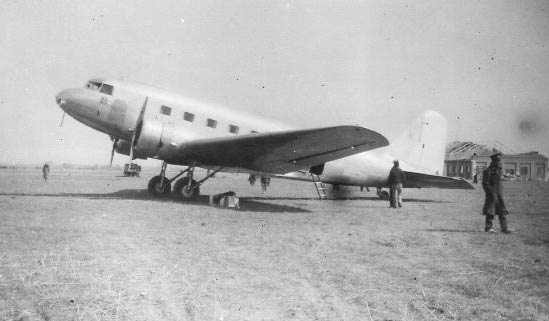 |
Just a couple of years later, in the mid-1930s, the Douglas DC-3 began flying passenger routes in the U.S. The DC-3 is generally credited with enabling economic commercial passenger service by making it comfortable and reliable. Among other rewards since, Douglas received the Collier Trophy in 1935 for numerous technical advancements incorporated in his DC-3. The award was made by President Roosevelt at the White House on June 26th. A single DC-3, NC14988, is a Register airplane. Below, from the SDAM, a portrait of a middle-aged Douglas signed to aircraft and engine manufacturer Al Menasco.
Donald W. Douglas Signed Portrait, Date Unknown (Source: SDAM)
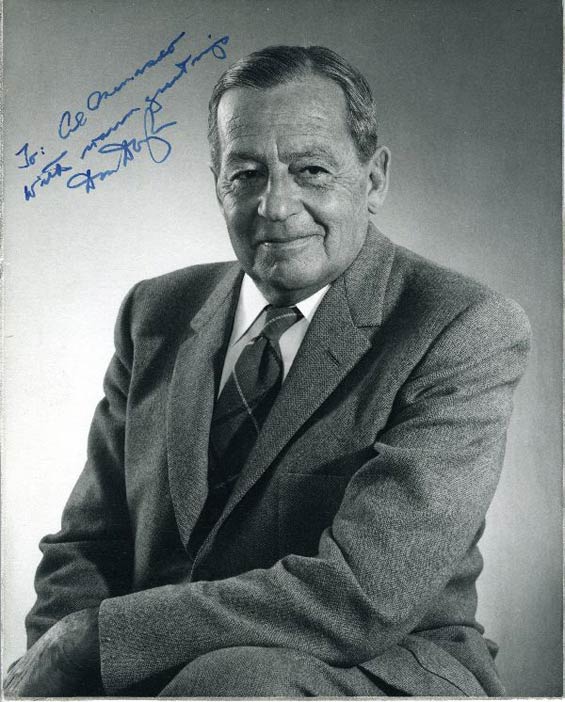 |
Douglas Aircraft Co. continued building larger and faster commercial aircraft under the DC (standing for "Douglas Commercial") insignia. For a period after WWII, more than half the airline passengers in the world were flown to their destinations by Douglas airliners. In the 1960s, Douglas entered the jet age with the DC-8, followed later by the DC-9 and the wide-bodied DC-10. In 1967, Douglas Aircraft merged with the McDonnell Co. of St. Louis, MO. McDonnell-Douglas was formed and Douglas remained with the firm as honorary board chairman. On August 1, 1997, McDonnell-Douglas merged with the Boeing Company.
After his health had been declining for some time, Douglas flew West on Sunday, February 1, 1981 in Palm Springs, CA. He was 88 years old. A "Salute to Donald Douglas" was entered into the Congressional Record of February 26, 1981. Douglas saw aviation grow across the world from wood and cloth machines to jets, all forms of which bore his name.
---o0o---
Dossier 2.3.2
THIS PAGE UPLOADED: 02/01/10 REVISED: 06/26/11, 01/19/15
|

